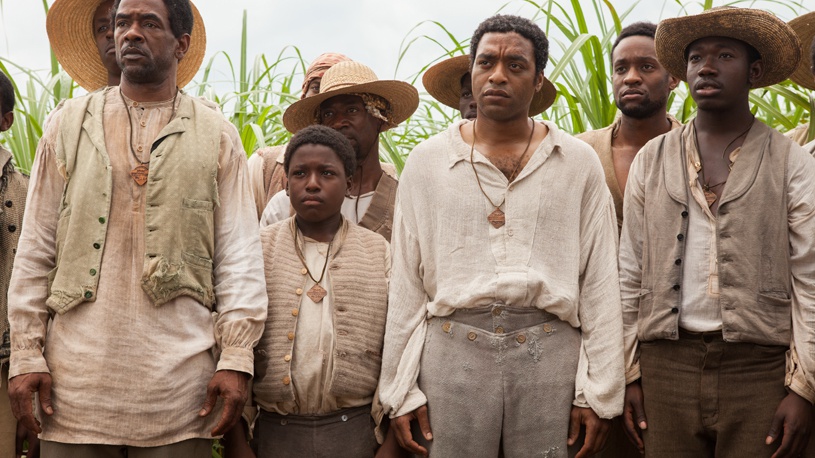Hunger, Steve McQueen’s 2008 debut feature film, shocked many with its abject depiction of violence and suffering, but it stood out equally for its unique structure: divided into three distinct parts, it sandwiched a twenty-minute, largely one-shot scene of dialogue between two sections that very silently and explicitly depicted Bobby Sands’s hunger strike.
What is at first most remarkable, then, about McQueen’s latest, 12 Years a Slave, is how, on a superficial level, it signals the director’s Hollywoodization: The film is finely attuned to the beats, tones, and visual style of Hollywood biopics and historical dramas—movies like Lincoln, but also The King’s Speech and Milk. It won’t immediately stand out among what will almost undoubtedly be its fellow Oscar nominees. But the same experimental tendencies that showed themselves in Hunger’s deliberately audacious structure remain present, more subtly, in 12 Years a Slave, raising the film to the level of a masterpiece.
Based on Solomon Northup’s best-selling 19th century memoir, the film tells the story of a free black man (Chiwetel Ejiofor) who was kidnapped in 1841 and sent into slavery for twelve years. The film follows him as he is sold first to a superficially well-meaning owner (Benedict Cumberbatch) and then to the sadistic Edwin Epps (a chilling Michael Fassbender). The development of Solomon’s character, however, occurs gradually. In fact, the finest part of Ejiofor’s performance is how slowly he releases the valve of his character’s despair.
In the meantime, McQueen very often shifts his gaze to other characters. Sometimes it’s for long periods, like in the case of Patsey (Lupita Nyong’o), a fellow slave on Solomon’s plantation who suffers from Epps’s adoration. Other times, the shift occurs only for a brief moment, such as in the shot of two nameless slaves being hung in the forest. But by building up a vision of the world into which Solomon is so unjustly thrown, 12 Years a Slave casts its protagonist not as the encapsulation of an era but as merely one lens through which to view it.
There is, in the film’s final scene, some talk of forgiveness, but it’s not asked of whom we might expect. Solomon’s suffering, of course, is harrowing to watch, whether the abuse is physical or comes in the form of being told to pretend, for his own safety, that he doesn’t know how to read, that he has none of his owners’ education. But it’s also true that Solomon is an exceptional case—technically a free man in a world of slaves whose condition is legally sanctioned—and so the movie’s moral and emotional punch comes equally from how successfully it details the horrific varieties of slave experience. There’s Solomon’s fellow slave on the ride from Washington to New Orleans, whose hard exterior turns into merciful gratitude when he runs into the arms of his owner, there to reclaim him when the ship reaches Louisiana. Or Mistress Shaw, who uses her owner’s affections toward her to gain some relative freedom on her plantation.
Of course, the film’s broad approach to portraying different circumstances within slavery rests vitally on its commitment to also displaying the system’s brutality front and center. McQueen presents us with numerous shots of swollen, bruised, and whiplashed backs and faces, as well as scenes of groups of slaves forced to dance in humiliating ways for their owners. It’s in portraying this aspect of slavery that McQueen also uses his considerable aesthetic talents with most tactical precision: After Solomon is kidnapped, he is transported south and the mix of sound design, music, and visuals—the spinning paddle wheels of the ship, the shoveling of coal—creates an overwhelming sensation of a descent into hell. Later in the film, the magisterial shot that McQueen uses to swoop through the home of Freeman (Paul Giamatti) as he tries to sell black men and women only emphasizes, in its ironically regal quality, the sickening way humans were treated like wares.
But perhaps the film’s most important accomplishment is how it lets us watch Solomon regain his freedom but does not offer redemption. There is, in the film’s final scene, some talk of forgiveness, but it’s not asked of whom we might expect. Hearing it packs what could have been solely a moment of relief with sadness and distress; it underlines, one last time, the psychological harm Solomon has suffered while also introducing a concept that feels completely out of place after everything we’ve witnessed. It brings to mind the words of Jean Améry, a Holocaust survivor, writing to fellow survivor Simon Wiesenthal:
Such a level of anger is never explicitly declared in 12 Years a Slave, but it’s the predominant emotion that crescendos throughout the film. Scene by scene, McQueen’s approach to his subject can seem cold and unemotional. However, as the injustices add up—some, like the violent whippings, presented repeatedly; others, like the sudden death of a slave who collapses while working in the cotton fields, shown in passing—the outrage becomes palpable. It’s a quality that most distinguishes 12 Years a Slave from Lincoln and Django Unchained, two worthy films nevertheless dwarfed by McQueen’s accomplishments here. Lincoln and Django’s power rest on their search and attainment of closure, whether of the legislative or vigilante kind. 12 Years a Slave’s hyper-realism, its unflinching stance, denies us that. Fuck closure, it says. What we’re talking about here are open wounds.

